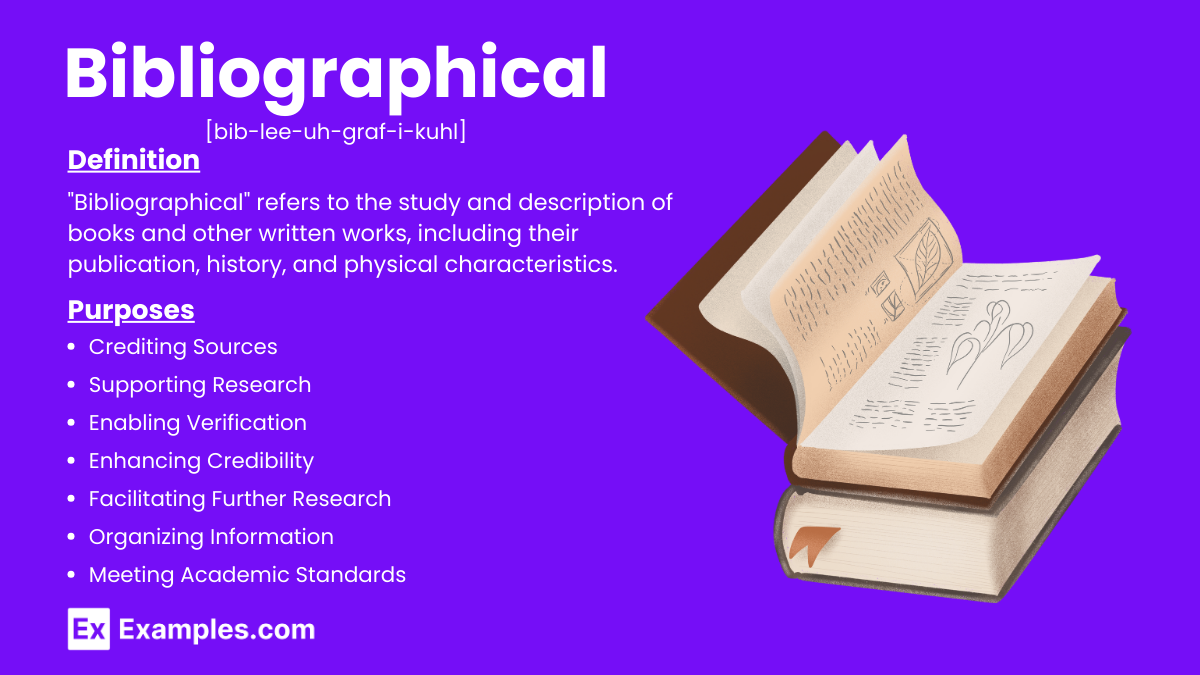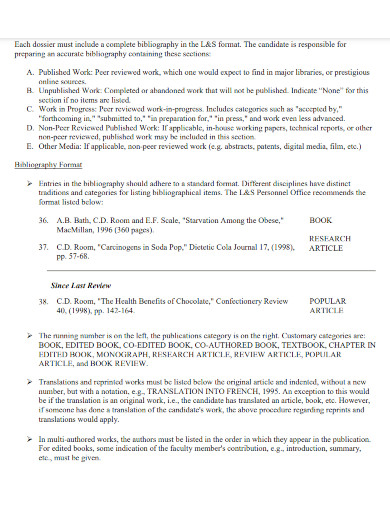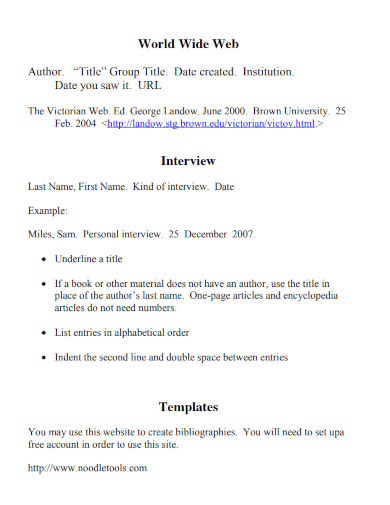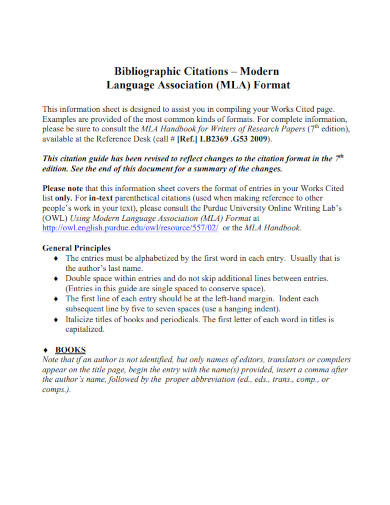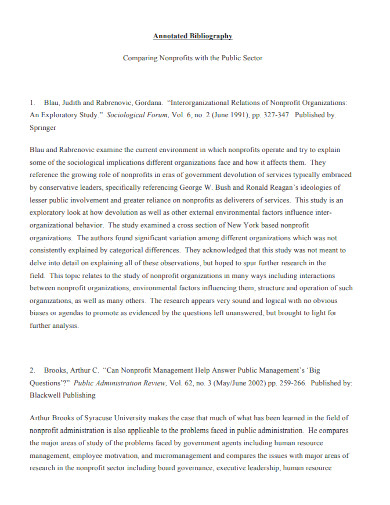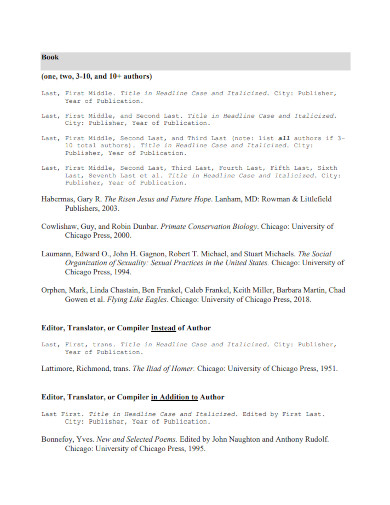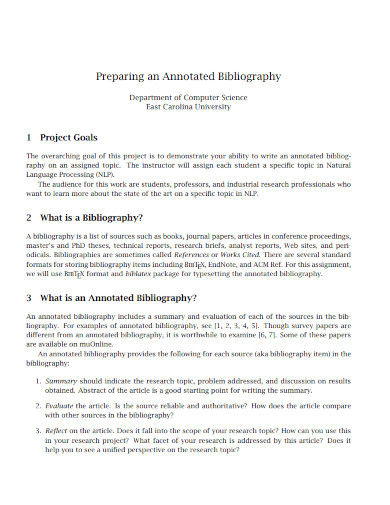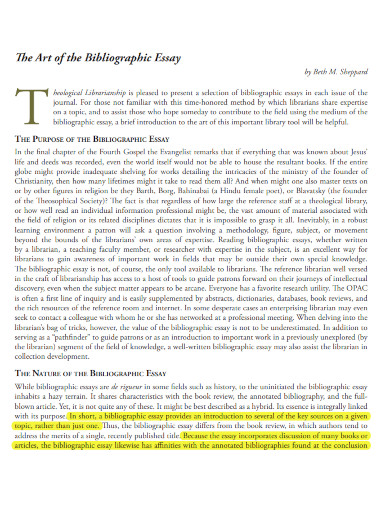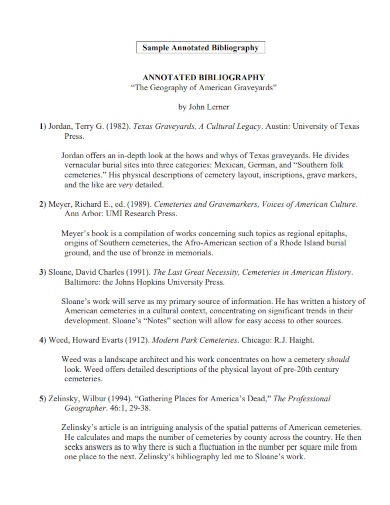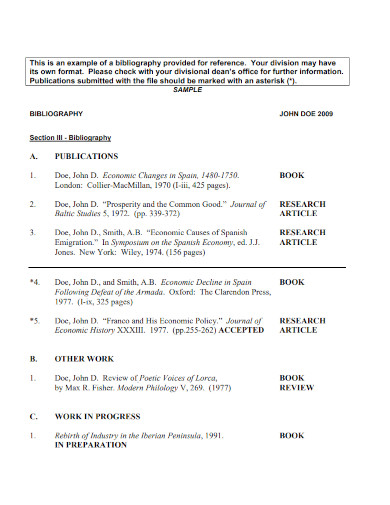30+ Bibliographical Examples
The scientific process allows people to research various topics and questions in a structured format. For the research paper to be valid and reliable the researcher must provide backing, context, and references through a bibliography.
What Is a Bibliography?
A bibliography is a list of books, articles, or other writings on a subject or by a particular author that were utilized in the creation of a research paper, book, or other work. A list of works cited is another name for it. Typically, you can find it near the conclusion of a book, essay, or research paper.
Bibliographic Format
Bibliographic format refers to the structured way of presenting information about sources such as books, articles, and other materials used in research. There are several styles commonly used in academic writing, including APA, MLA, and Chicago. Below are the guidelines for each format:
1. APA (American Psychological Association) Style
- Books:
- Author(s). (Year). Title of the book. Publisher.
Example: Smith, J. A. (2020). Understanding Psychology. Pearson.
- Journal Articles:
- Author(s). (Year). Title of the article. Title of the Journal, volume number(issue number), page range. DOI
Example: Brown, L. M., & Green, K. S. (2019). The effects of sleep on cognitive performance. Journal of Sleep Research, 28(4), 445-456. https://doi.org/10.1111/jsr.12766
- Websites:
- Author(s). (Year, Month Day). Title of the webpage. Website Name. URL
Example: Johnson, R. (2021, March 15). The future of artificial intelligence. Tech World. https://www.techworld.com/articles/ai-future
2. MLA (Modern Language Association) Style
- Books:
- Author(s). Title of the Book. Publisher, Year.
Example: Smith, John A. Understanding Psychology. Pearson, 2020.
- Journal Articles:
- Author(s). “Title of the Article.” Title of the Journal, vol. number, no. number, Year, pages. Database, DOI.
Example: Brown, Lisa M., and Kevin S. Green. “The Effects of Sleep on Cognitive Performance.” Journal of Sleep Research, vol. 28, no. 4, 2019, pp. 445-456. JSTOR, https://doi.org/10.1111/jsr.12766.
- Websites:
- Author(s). “Title of the Webpage.” Website Name, Publisher (if different from the website name), Date, URL.
Example: Johnson, Roberta. “The Future of Artificial Intelligence.” Tech World, 15 Mar. 2021, https://www.techworld.com/articles/ai-future.
3. Chicago Style
- Books:
- Author(s). Title of the Book. Place of publication: Publisher, Year.
Example: Smith, John A. Understanding Psychology. New York: Pearson, 2020.
- Journal Articles:
- Author(s). “Title of the Article.” Title of the Journal volume number, no. issue number (Year): page range. DOI.
Example: Brown, Lisa M., and Kevin S. Green. “The Effects of Sleep on Cognitive Performance.” Journal of Sleep Research 28, no. 4 (2019): 445-456. https://doi.org/10.1111/jsr.12766.
- Websites:
- Author(s). “Title of Webpage.” Website Name. Last modified Date. URL.
Example: Johnson, Roberta. “The Future of Artificial Intelligence.” Tech World. Last modified March 15, 2021. https://www.techworld.com/articles/ai-future.
Bibliographical List
A bibliographical list is a compilation of references used in research, formatted according to a specific citation style. Below are examples of bibliographical lists in APA, MLA, and Chicago styles:
APA Style
- Books:
- Smith, J. A. (2020). Understanding Psychology. Pearson.
- Journal Articles:
- Brown, L. M., & Green, K. S. (2019). The effects of sleep on cognitive performance. Journal of Sleep Research, 28(4), 445-456. https://doi.org/10.1111/jsr.12766
- Websites:
- Johnson, R. (2021, March 15). The future of artificial intelligence. Tech World. https://www.techworld.com/articles/ai-future
MLA Style
- Books:
- Smith, John A. Understanding Psychology. Pearson, 2020.
- Journal Articles:
- Brown, Lisa M., and Kevin S. Green. “The Effects of Sleep on Cognitive Performance.” Journal of Sleep Research, vol. 28, no. 4, 2019, pp. 445-456. JSTOR, https://doi.org/10.1111/jsr.12766.
- Websites:
- Johnson, Roberta. “The Future of Artificial Intelligence.” Tech World, 15 Mar. 2021, https://www.techworld.com/articles/ai-future.
Chicago Style
- Books:
- Smith, John A. Understanding Psychology. New York: Pearson, 2020.
- Journal Articles:
- Brown, Lisa M., and Kevin S. Green. “The Effects of Sleep on Cognitive Performance.” Journal of Sleep Research 28, no. 4 (2019): 445-456. https://doi.org/10.1111/jsr.12766.
- Websites:
- Johnson, Roberta. “The Future of Artificial Intelligence.” Tech World. Last modified March 15, 2021. https://www.techworld.com/articles/ai-future.
Bibliographical Examples
Bibliographical Examples for Students
1. Book
Format: Author(s). (Year of Publication). Title of the book. Publisher.
Example: Smith, J. (2020). The Art of Effective Study. Academic Press.
2. Journal Article
Format: Author(s). (Year of Publication). Title of the article. Title of the Journal, Volume(Issue), Page numbers. DOI or URL
Example: Johnson, L. & Lee, M. (2021). The impact of social media on student productivity. Journal of Educational Psychology, 33(4), 456-469. https://doi.org/10.1234/jep.2021.0456
3. Website
Format: Author(s) or Organization. (Year, Month Date). Title of the webpage. Website Name. URL
Example: National Institute of Mental Health. (2022, January 15). Tips for managing stress. NIMH. https://www.nimh.nih.gov/tips-for-managing-stress
4. Book Chapter
Format: Author(s) of the chapter. (Year of Publication). Title of the chapter. In Editor(s) of the book (Ed(s).), Title of the book (pp. Page numbers). Publisher.
Example: Brown, R. (2019). Cognitive development in early childhood. In S. Green & P. White (Eds.), Foundations of Child Psychology (pp. 45-68). Springer.
5. Conference Paper
Format: Author(s). (Year, Month). Title of the paper. In Editor(s) (Ed(s).), Title of the conference proceedings (pp. Page numbers). Publisher. DOI or URL (if available)
Example: Davis, K. (2023, March). Innovative teaching strategies in higher education. In T. Lee (Ed.), Proceedings of the International Conference on Education (pp. 123-130). Academic Publishing. https://doi.org/10.1234/ice.2023.0123
6. Dissertation/Thesis
Format: Author. (Year). Title of the dissertation/thesis (Doctoral dissertation/Master’s thesis). University. URL (if available)
Example: Clark, A. (2020). Exploring the relationship between study habits and academic performance (Master’s thesis). University of Education. http://www.educationuniversity.edu/theses/clark2020
7. Newspaper Article
Format: Author(s). (Year, Month Date). Title of the article. Title of the Newspaper, Page number(s).
Example: Jones, M. (2024, February 10). New approaches to remote learning. The Daily Times, pp. A1, A3.
8. Online Video
Format: Author/Creator. (Year, Month Date). Title of the video [Video]. Platform. URL
Example: Khan Academy. (2022, March 15). Understanding calculus [Video]. YouTube. https://www.youtube.com/watch?v=abcd1234
9. Blog Post
Format: Author(s). (Year, Month Date). Title of the blog post. Blog Name. URL
Example: Taylor, S. (2021, November 5). 10 tips for effective study habits. Student Success Blog. https://www.studentsuccessblog.com/effective-study-habits
10. Magazine Article
Format: Author(s). (Year, Month Date). Title of the article. Title of the Magazine, Volume(Issue), Page numbers.
Example: Martinez, L. (2023, June 10). The future of educational technology. Education Today, 45(6), 22-25.
Bibliographical Examples in Research
1. Book
Format: Author(s). (Year of Publication). Title of the book. Publisher.
Example: Smith, J. (2020). The Art of Effective Study. Academic Press.
2. Journal Article
Format: Author(s). (Year of Publication). Title of the article. Title of the Journal, Volume(Issue), Page numbers. DOI or URL
Example: Johnson, L. & Lee, M. (2021). The impact of social media on student productivity. Journal of Educational Psychology, 33(4), 456-469. https://doi.org/10.1234/jep.2021.0456
3. Website
Format: Author(s) or Organization. (Year, Month Date). Title of the webpage. Website Name. URL
Example: National Institute of Mental Health. (2022, January 15). Tips for managing stress. NIMH. https://www.nimh.nih.gov/tips-for-managing-stress
4. Book Chapter
Format: Author(s) of the chapter. (Year of Publication). Title of the chapter. In Editor(s) of the book (Ed(s).), Title of the book (pp. Page numbers). Publisher.
Example: Brown, R. (2019). Cognitive development in early childhood. In S. Green & P. White (Eds.), Foundations of Child Psychology (pp. 45-68). Springer.
5. Conference Paper
Format: Author(s). (Year, Month). Title of the paper. In Editor(s) (Ed(s).), Title of the conference proceedings (pp. Page numbers). Publisher. DOI or URL (if available)
Example: Davis, K. (2023, March). Innovative teaching strategies in higher education. In T. Lee (Ed.), Proceedings of the International Conference on Education (pp. 123-130). Academic Publishing. https://doi.org/10.1234/ice.2023.0123
6. Dissertation/Thesis
Format: Author. (Year). Title of the dissertation/thesis (Doctoral dissertation/Master’s thesis). University. URL (if available)
Example: Clark, A. (2020). Exploring the relationship between study habits and academic performance (Master’s thesis). University of Education. http://www.educationuniversity.edu/theses/clark2020
7. Newspaper Article
Format: Author(s). (Year, Month Date). Title of the article. Title of the Newspaper, Page number(s).
Example: Jones, M. (2024, February 10). New approaches to remote learning. The Daily Times, pp. A1, A3.
8. Online Video
Format: Author/Creator. (Year, Month Date). Title of the video [Video]. Platform. URL
Example: Khan Academy. (2022, March 15). Understanding calculus [Video]. YouTube. https://www.youtube.com/watch?v=abcd1234
9. Blog Post
Format: Author(s). (Year, Month Date). Title of the blog post. Blog Name. URL
Example: Taylor, S. (2021, November 5). 10 tips for effective study habits. Student Success Blog. https://www.studentsuccessblog.com/effective-study-habits
10. Magazine Article
Format: Author(s). (Year, Month Date). Title of the article. Title of the Magazine, Volume(Issue), Page numbers.
Example: Martinez, L. (2023, June 10). The future of educational technology. Education Today, 45(6), 22-25.
Bibliographical Examples for School Project
1. Book
Format: Author(s). (Year of Publication). Title of the book. Publisher.
Example: Smith, J. (2020). The Art of Effective Study. Academic Press.
2. Journal Article
Format: Author(s). (Year of Publication). Title of the article. Title of the Journal, Volume(Issue), Page numbers. DOI or URL
Example: Johnson, L. & Lee, M. (2021). The impact of social media on student productivity. Journal of Educational Psychology, 33(4), 456-469. https://doi.org/10.1234/jep.2021.0456
3. Website
Format: Author(s) or Organization. (Year, Month Date). Title of the webpage. Website Name. URL
Example: National Institute of Mental Health. (2022, January 15). Tips for managing stress. NIMH. https://www.nimh.nih.gov/tips-for-managing-stress
4. Book Chapter
Format: Author(s) of the chapter. (Year of Publication). Title of the chapter. In Editor(s) of the book (Ed(s).), Title of the book (pp. Page numbers). Publisher.
Example: Brown, R. (2019). Cognitive development in early childhood. In S. Green & P. White (Eds.), Foundations of Child Psychology (pp. 45-68). Springer.
5. Conference Paper
Format: Author(s). (Year, Month). Title of the paper. In Editor(s) (Ed(s).), Title of the conference proceedings (pp. Page numbers). Publisher. DOI or URL (if available)
Example: Davis, K. (2023, March). Innovative teaching strategies in higher education. In T. Lee (Ed.), Proceedings of the International Conference on Education (pp. 123-130). Academic Publishing. https://doi.org/10.1234/ice.2023.0123
6. Dissertation/Thesis
Format: Author. (Year). Title of the dissertation/thesis (Doctoral dissertation/Master’s thesis). University. URL (if available)
Example: Clark, A. (2020). Exploring the relationship between study habits and academic performance (Master’s thesis). University of Education. http://www.educationuniversity.edu/theses/clark2020
7. Newspaper Article
Format: Author(s). (Year, Month Date). Title of the article. Title of the Newspaper, Page number(s).
Example: Jones, M. (2024, February 10). New approaches to remote learning. The Daily Times, pp. A1, A3.
8. Online Video
Format: Author/Creator. (Year, Month Date). Title of the video [Video]. Platform. URL
Example: Khan Academy. (2022, March 15). Understanding calculus [Video]. YouTube. https://www.youtube.com/watch?v=abcd1234
9. Blog Post
Format: Author(s). (Year, Month Date). Title of the blog post. Blog Name. URL
Example: Taylor, S. (2021, November 5). 10 tips for effective study habits. Student Success Blog. https://www.studentsuccessblog.com/effective-study-habits
10. Magazine Article
Format: Author(s). (Year, Month Date). Title of the article. Title of the Magazine, Volume(Issue), Page numbers.
Example: Martinez, L. (2023, June 10). The future of educational technology. Education Today, 45(6), 22-25.
More Bibliographical Examples & Samples in PDF
1. Bibliography Format
2. Elementary Bibliography Style Sheet
3. Bibliographic Citations
4. Annotated Bibliography Example
5. Turabian Bibliography Examples
6. APA Bibliographical Citation Format
7. Preparing Annotated Bibliography
8. Art of Bibliographic Essay
9. Sample Annotated Bibliography
10. Bibliography Sample
Purpose of Bibliographic
A bibliography serves several crucial purposes in academic research and writing. It is a comprehensive list of all the sources cited or referenced in a piece of work. Here are the primary purposes of a bibliography:
1. Crediting Sources
A bibliography provides proper credit to the authors and creators of the works that have informed and supported your research. This recognition is essential for maintaining academic integrity and avoiding plagiarism.
2. Supporting Research
A well-constructed bibliography demonstrates the depth and breadth of your research. It shows that you have consulted a wide range of sources and that your work is based on solid evidence and scholarly input.
3. Enabling Verification
A bibliography allows readers to locate the sources you have used. This transparency is essential for verifying the accuracy of your information and the legitimacy of your arguments. Readers can follow up on your sources to see if they agree with your interpretations and conclusions.
4. Enhancing Credibility
Including a bibliography enhances your credibility as a researcher. It shows that you have engaged thoroughly with existing literature and that your work is grounded in established knowledge.
5. Facilitating Further Research
A bibliography provides a valuable resource for other researchers. It can guide them to relevant sources and help them build on your work. This is particularly useful for advancing knowledge within a specific field.
6. Organizing Information
Creating a bibliography helps you organize your sources systematically. This organization can make it easier to review your references, ensure all citations are accounted for, and maintain consistency in your citations.
7. Meeting Academic Standards
Most academic institutions and publishers have strict requirements regarding citation and referencing. A bibliography is a mandatory component of academic writing that helps meet these standards
How to Write a Bibliography in APA Text Format
Step 1: Title Your Bibliography
- Title: “References” centered at the top of the page.
Step 2: General Formatting
- Font: Times New Roman, 12-point size.
- Spacing: Double-space all text.
- Indentation: Use a hanging indent.
- Order: Alphabetical by the author’s last name.
Step 3: Formatting Examples
Book
Format:
- Author, A. A. (Year). Title of the book. Publisher.
Example:
- Smith, J. A. (2020). Understanding psychology. Pearson.
Journal Article
Format:
- Author, A. A., & Author, B. B. (Year). Title of the article. Title of the Journal, volume number(issue number), page range. DOI
Example:
- Brown, L. M., & Green, K. S. (2019). The effects of sleep on cognitive performance. Journal of Sleep Research, 28(4), 445-456. https://doi.org/10.1111/jsr.12766
Website
Format:
- Author, A. A. (Year, Month Day). Title of the webpage. Website Name. URL
Example:
- Johnson, R. (2021, March 15). The future of artificial intelligence. Tech World. https://www.techworld.com/articles/ai-future
Edited Book
Format:
- Editor, E. E. (Ed.). (Year). Title of the book. Publisher.
Example:
- Harris, P. L. (Ed.). (2018). Child development: An introduction. McGraw-Hill.
Chapter in Edited Book
Format:
- Author, A. A. (Year). Title of the chapter. In E. E. Editor (Ed.), Title of the book (pp. page range). Publisher.
Example:
- Nguyen, T. K. (2017). Language acquisition in early childhood. In P. L. Harris (Ed.), Child development: An introduction (pp. 45-67). McGraw-Hill.
Why is a bibliography important?
It gives credit to original authors, prevents plagiarism, and allows readers to verify sources.
What is the difference between a bibliography and a reference list?
A bibliography includes all consulted sources, while a reference list includes only cited sources.
How should a bibliography be formatted?
Follow a specific citation style (APA, MLA, Chicago), use double spacing, and apply a hanging indent.
What is a hanging indent?
The first line of each reference is flush left, and subsequent lines are indented by 0.5 inches.
How do you alphabetize a bibliography?
Arrange entries by the first author’s last name or by title if no author is listed.
What information is needed for a book citation?
Include the author’s name, publication year, book title, and publisher.
How do you cite a journal article in APA?
Include the authors, publication year, article title, journal name, volume, issue, pages, and DOI.
What if there are multiple authors?
List up to 20 authors in APA format, separating names with commas and using an ampersand before the last author.
How do you cite an online source?
Include the author, date, title, website name, and URL.
How do you cite a chapter in an edited book?
List the chapter author, year, chapter title, editor, book title, pages, and publisher.



